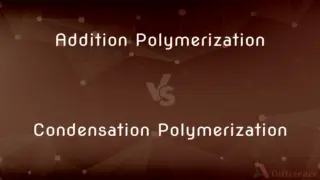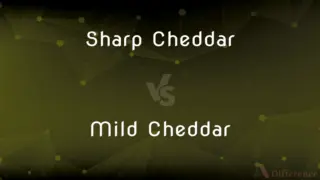Insertion Sort vs. Selection Sort — What's the Difference?
By Tayyaba Rehman — Published on January 3, 2024
Insertion Sort builds a sorted array one item at a time, while Selection Sort repeatedly finds the minimum element and places it at the start.

Difference Between Insertion Sort and Selection Sort
Table of Contents
ADVERTISEMENT
Key Differences
Insertion Sort is a sorting algorithm where elements are sorted one by one, inserting each item into its proper place in the already sorted part. Selection Sort, conversely, sorts an array by repeatedly finding the minimum element from the unsorted part and moving it to the beginning.
In Insertion Sort, the array is virtually split into a sorted and unsorted part. Values from the unsorted part are picked and placed at the correct position in the sorted part. In Selection Sort, the entire array is scanned to find the smallest element, which is then swapped with the first element of the unsorted part.
Insertion Sort is generally more efficient for small data sets or arrays that are already partially sorted, as fewer movements are needed. Selection Sort does not have this adaptive nature and performs the same number of comparisons regardless of the initial order of elements.
The complexity of Insertion Sort in the best-case scenario (already sorted array) is O(n), while for Selection Sort, it remains O(n²) even in the best case. This makes Insertion Sort more efficient in certain situations.
Insertion Sort is more efficient in terms of memory writes compared to Selection Sort, as it doesn’t swap elements as much, which can be important for scenarios where writing to memory is a costly operation.
ADVERTISEMENT
Comparison Chart
Mechanism
Sorts by inserting elements into sorted array.
Finds minimum and swaps with start of unsorted part.
Efficiency
More efficient for small or partially sorted arrays.
Consistent performance, but generally slower.
Best Case Complexity
O(n) for nearly sorted array.
O(n²), even for nearly sorted array.
Memory Writes
Fewer, as it involves less swapping.
More, due to frequent swapping.
Adaptiveness
Adaptive to the existing order of elements.
Non-adaptive, same number of comparisons regardless of order.
Compare with Definitions
Insertion Sort
Insertion Sort is a simple sorting algorithm that builds the final sorted array one item at a time.
I used Insertion Sort to efficiently organize the nearly sorted list of numbers.
Selection Sort
Selection Sort is a sorting algorithm that divides the array into a sorted and unsorted region, and repeatedly selects the smallest element from the unsorted region to add to the sorted region.
We used Selection Sort to methodically find and position each minimum element in our dataset.
Insertion Sort
Insertion Sort is adaptive, with time complexity reducing for partially sorted arrays.
The efficiency of Insertion Sort increased as the array elements were closely arranged.
Selection Sort
It works by selecting the minimum element from the unsorted part and swapping it with the leftmost unsorted element.
Selection Sort continuously swapped the next smallest number with the first number of the unsorted section.
Insertion Sort
It works by taking elements from an unsorted array and inserting them at the correct position in a sorted section.
In Insertion Sort, each new element is compared with already sorted ones to find its proper place.
Selection Sort
It is not adaptive and performs the same number of operations regardless of the initial array order.
Regardless of the array's initial state, Selection Sort performed its full iteration process.
Insertion Sort
Insertion Sort is efficient for small data sets.
For our small dataset, Insertion Sort was the quickest sorting method.
Selection Sort
Selection Sort involves more memory writes compared to some other sorts, due to the swapping process.
Selection Sort made numerous swaps, leading to increased memory writes during sorting.
Insertion Sort
It provides a good solution when the array is already partially sorted.
Since the array was almost sorted, Insertion Sort completed the task rapidly.
Selection Sort
Selection Sort has a consistent time complexity of O(n²) regardless of the initial order of elements.
Even though our data was nearly organized, Selection Sort took the same amount of time to sort.
Common Curiosities
Is Insertion Sort faster than Selection Sort?
Yes, Insertion Sort is generally faster, especially for nearly sorted data.
Can Insertion Sort be used for large data sets?
It's not ideal for large datasets as its efficiency decreases significantly with larger arrays.
What is Insertion Sort best used for?
Insertion Sort is best for small or nearly sorted datasets.
Which sort is better for data with lots of swaps?
Insertion Sort is generally better since it involves fewer swaps.
In what scenario is Selection Sort a good choice?
Selection Sort is suitable for small arrays where simplicity and ease of implementation are more important than efficiency.
How does Selection Sort perform in terms of memory usage?
Selection Sort requires more memory writes due to swapping elements.
How does the complexity of Insertion Sort change with data order?
Insertion Sort’s complexity can improve to O(n) with nearly sorted data.
Why is Selection Sort not adaptive?
Selection Sort performs the same number of comparisons regardless of the initial order, making it non-adaptive.
What is the space complexity of Insertion Sort?
Insertion Sort has a space complexity of O(1), making it an in-place sorting algorithm.
Are Insertion and Selection Sorts suitable for parallel processing?
Generally, no. Both are more suited for sequential processing due to their nature.
Is Selection Sort stable?
No, Selection Sort is not stable as it can change the relative order of equal elements.
How does the worst-case time complexity of both sorts compare?
Both have a worst-case complexity of O(n²), but Insertion Sort often performs better.
Is Selection Sort easy to code?
Yes, Selection Sort is straightforward and easy to implement.
Can Selection Sort be made stable?
It's possible with modifications, but the standard implementation is not stable.
Can Insertion Sort be optimized for better performance?
Yes, binary insertion sort is an optimization that can improve performance in some cases.
Share Your Discovery

Previous Comparison
Addition Polymerization vs. Condensation Polymerization
Next Comparison
Sharp Cheddar vs. Mild CheddarAuthor Spotlight
Written by
Tayyaba RehmanTayyaba Rehman is a distinguished writer, currently serving as a primary contributor to askdifference.com. As a researcher in semantics and etymology, Tayyaba's passion for the complexity of languages and their distinctions has found a perfect home on the platform. Tayyaba delves into the intricacies of language, distinguishing between commonly confused words and phrases, thereby providing clarity for readers worldwide.












































